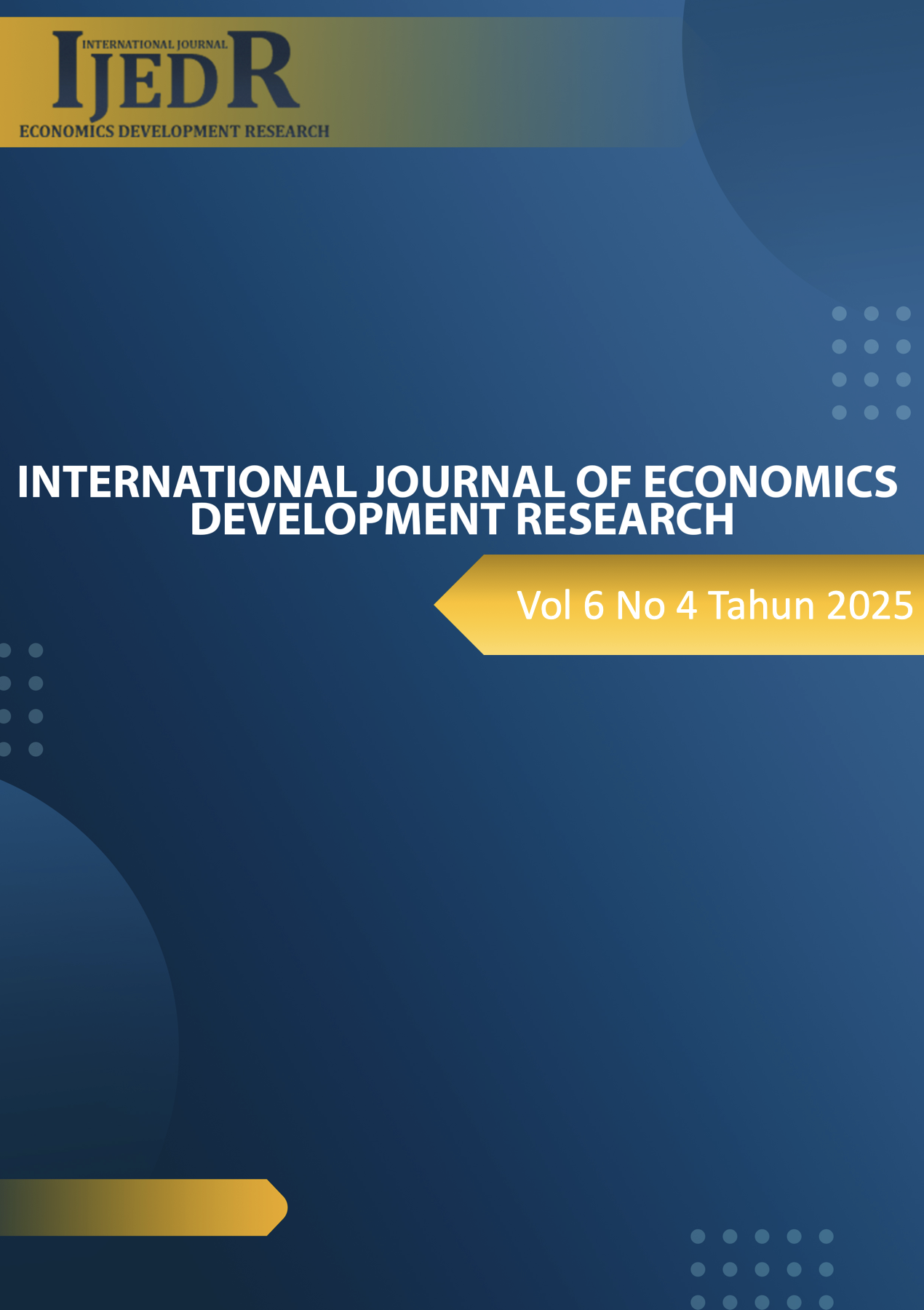Spatial Land Suitability for Paddy Cultivation: Empirical Analysis of Its Impact on Export Volume and Exchange Rates Behavior in Indonesia
DOI:
https://doi.org/10.37385/ijedr.v6i4.7908Keywords:
Agricultural Policy, Exchange Rate, Food Security, Land Suitability, Spatial-MacroeconomicsAbstract
This study explores the linkages between geographical land suitability for rice cultivation and fluctuations in the Rupiah to US Dollar (IDR/USD) exchange rate in Indonesia's macroeconomic context. Combining qualitative and quantitative approaches, the study involved stakeholder interviews and regression analysis of national economic time series data from 1994 to 2024. Spatial analysis using the Multi-Criteria Decision Analysis (MCDA) approach was used to assess land suitability, considering legal restrictions on conversion of paddy fields and conservation forests. Results show that land suitability-based rice production has a statistically significant effect on exchange rate at the 10% level (p = 0.0883), with a positive coefficient of 0.0499, indicating that increased production is associated with Rupiah depreciation. In contrast, GRDP shows a significant negative effect on the exchange rate (p < 0.05), indicating its contribution to currency appreciation. Mediation analysis revealed that although rice production significantly increased export volume (p = 0.0053), the relationship between export and exchange rate did not prove significant (p = 0.3962). This suggests that increased production does not automatically strengthen the exchange rate without effective integration into the trading system. The qualitative interviews highlighted the importance of adaptive strategies by stakeholders in food security management. The findings emphasize the need for synchronization between agricultural expansion policies and macroeconomic strategies to sustainably achieve exchange rate stability and national food security.
References
AJMRD. (2024). Regional rice competitiveness through BUMD-based milling factories [Online post]. ASEAN Journal of Market and Rural Development.
Azkiya, R., Rahmawati, D., & Suparlan, S. (2024). Community inclusion in agricultural policy: Lessons from food estate failures in Indonesia. Journal of Agrarian Change, 24(1), 55–70.
Baron, R. M., & Kenny, D. A. (1986). The moderator–mediator variable distinction in social psychological research: Conceptual, strategic, and statistical considerations. Journal of Personality and Social Psychology, 51(6), 1173–1182. https://doi.org/10.1037/0022-3514.51.6.1173
Barro, R. J. (1990). Government spending in a simple model of endogenous growth. Journal of Political Economy, 98(5, Part 2), S103–S125. https://doi.org/10.1086/261726
Central Statistics Agency (BPS). (2024). Kutai Kartanegara regency [Online post]. Kutai Kartanegara in Numbers 1997–2024. https://kukar.bps.go.id
Choudhary, V. (2023). Geospatial AHP-based land evaluation for rice production. International Journal of GIS and Remote Sensing, 45(3), 112–130.
Gatawa, N. M., & Mahmud, A. A. (2017). Impact of exchange rate fluctuations on agricultural exports (crops) in Nigeria. International Journal of Humanities and Social Science Invention, 6(3), 65–71.
Gujarati, D. N. (2003). Basic econometrics (4th ed.). McGraw-Hill.
Laksono, R. (2023). Does trade liberalization improve competition and allocative efficiency? Evidence from Indonesia’s Manufacturing Sector. Journal of Policy and Development, 32(2), 77–89. https://doi.org/10.13140/RG.2.2.32363.92963
Malczewski, J. (2004). GIS-based land-use suitability analysis: A critical overview. Progress in Planning, 62(1), 1–2. https://doi.org/10.1016/j.progress.2003.09.001
Pakpahan, A. (2020). Evaluating the food estate model in Indonesia: Infrastructure and outcome gaps. Policy Review Indonesia, 7(1), 18–30.
President of the Republic of Indonesia. (2020). Presidential Regulation of the Republic of Indonesia Number 109 of 2020 concerning the Acceleration of the National Food Estate Development Program (Food Estate). https://peraturan.go.id
Setyanto, P. (2023). Peta kesesuaian lahan untuk padi di Kalimantan Timur: Kajian elevasi dan bahaya banjir. Balai Penelitian Tanah.
Statista. (2024). Exchange rates of Indonesian Rupiah to USD. https://www.statista.com/statistics/808073/indonesia-exchange-rate-against-us-dollar
World Bank. (2024). World development indicators. https://data.worldbank.org
World Resources Institute (WRI). (2022). Lessons from the food estate project: Deforestation and resilience risks [Online post]. https://wri-indonesia.org
Yusiana, S., Harahap, R., & Pranowo, S. (2022). Macroeconomic drivers of rice exports: Empirical findings from Indonesia. Journal of International Trade and Development, 31(3), 243–259. https://doi.org/10.1080/09638199.2022.1234567





